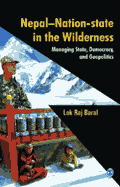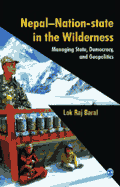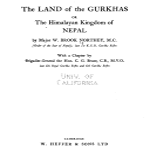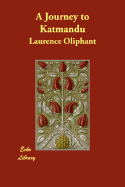
Lok Raj Baral, Nepal – Nation-State in the Wilderness: Managing State, Democracy and Geopolitics (New Delhi: Sage Publications, 2012)
Nepal is at very crucial stage of its history as a “nation state.” While every state by definition is a political and a geographical unit; the nation is a composite cultural and/or ethnic creature. This creature can be defined as group of people who are bound together into a single entity, through history, customs, value, language, culture, tradition, art and religion.
On the contrary, a state is just a patch of land with a sovereign government. As a politico-judicial entity, which is identified by its sovereign rights, a political state constrains the intrusion of outsiders in its internal affairs. When ‘nation’ and ‘state’ coincide, they form a “nation state” which not only assumes a collective political existence of the people living together with an official language(s), a system of law, a currency system, and a bureaucracy to order elements of society, but also presupposes the diversity of unified national identity.
As a nation state, Nepal has its own realities. The new book of Professor Lok Raj Baral Nepal: Nation-State in the Wilderness is a comprehensive attempt to explore these realities in the background of its history and the efforts towards democratic consolidation. Several weeks of mass protests in April 2006 followed by several months of peace negotiations between the underground Communist Party of Nepal (Maoists), the crisis government dealing with the so called ‘people’s war’ and Indian agencies, often acting behind the scene, overturned the evolutionary process of change in Nepal. It also set aside the course of the policy of national reconciliation – the basis of Nepal’s political development so far. This is a significant aspect of recent political change in Nepal. Baral has tried to explain this change on the basis of his characteristic vantage point.
The new process culminated in (a) a November 2006 peace accord, (b) the promulgation of an interim constitution and (c) the elections to the constituent assembly. The assembly elected to draft and adopt a new constitution for the country was expected to chart out a new democratic vision for Nepal and its system of government. Baral explores the contours of the nation state in the wilderness covering a wide spectrum of important issues around these changes, their antecedents, future course and beyond.
There are six chapters in the book. As an introductory chapter, Chapter I is devoted to trace out the parameters of Nepali politics: the thrust of Nepalese people for liberal democracy, ambiguities in the change process, political disjuncture or break with the tradition and the 2006 mass movement. Here, he also describes what he considers the rediscovery of a nation state, values of secularism, the role of fractured parties, and external influence in the politics of Nepal. Chapter II is a precise effort to revisit Nepali state. Baral explains the wars Nepal fought in the history, the treaties it signed and signposts of Nepal’s diplomacy in Chapter III. Then follow a sizable chapter on the issues of democracy, peace and development. In Chapter V, Baral explains Nepal vis a vis the modern world, focusing on the geopolitics. Here, Baral discusses Nepal in the context of its immediate neighborhood. The last chapter is an analysis for the future.
In his preface to the book, Baral maintains that the work is the product of his “long observation and study of Nepali state, politics, political elites, and their orientation.” He has described the finding of his research as the “sum and substance of [his] long academic career.” Although he does not clearly specify the objective of the book, he has unmistakably “tried to make a unified theme by knitting together the origin, growth and limitations of the modern Nepali state, people’s role that came by way of their desire for democracy and the active geo-politics.” The author acknowledges that the book “does not provide any definite clue to the future of Nepali state and democracy. Yet it gives a perspective on the unfolding scenario and their consequences.”
Mapping the overall situation of Nepal, and its future challenges, the concluding paragraph of Baral’s last chapter has the following direction: “Paradoxically the state [in Nepal] has not reached the terminal point [despite the vicissitudes that he has explained]; neither has it given us any promising picture for the future. Democracy is in peril, so is the vitality of the state. Prolonged transition and polarized and uncertain politics may be more alarming when foreign powers start showing their active presence than ever before and when the political and other elites become too weak to manage them. Political parties that take position for and against any country themselves would make these powers active and interventionist as the recent developments have demonstrated.” The reference apparently hints at India, and responses of Nepal’s major political parties on its ghastly meddling in Nepal, its internal affairs and external relations.
What has not been covered in the book of Baral is the sad reality that all these efforts in the post 2006 scenario and the actors who led the process failed. Had Baral waited by any chance for another couple of months to publish his work, he would have been able to cover the 27 May 2012 demise of the constituent assembly without accomplishing its task, and the nature of disaster that the country is to manage in the upcoming months. By all these machinations, India has established itself in Nepal, setting aside the factors of stability and sustainable political development. This is the factor that will continue to trigger off quiet responses from other quarters as well.
If this particular perspective is not ignored, many of Baral’s arguments on monarchy, the process of national unification and evolution of Nepal’s politics, the challenges of national reconciliation and nation building, and the role of neighboring countries might entail alternative explanations. As Nepal moves into the second decade of the 21st century, a new power rivalry is taking shape between India and China. It does not seem to be possible to explain the “nation-state in the wilderness” without giving credence to the fact that Nepal is in the range of high-tech geopolitics. The context of the collapse of distance brought about by the advance of military technology must not be minimized. For an average Nepalese, what ails more is Nepal’s national security. The treatment given by Professor Baral to this aspect of his theme is not adequate.
Yet the book Nepal – Nation-State in the Wilderness is a significant addition in the library of political science of contemporary Nepal. It is a ‘must read” book for the political analysts of Nepal and abroad who want to pursue his themes more.




